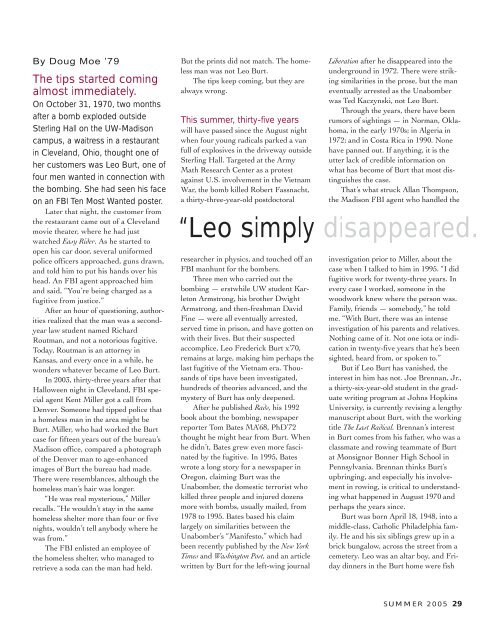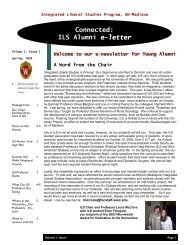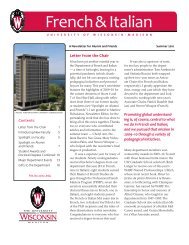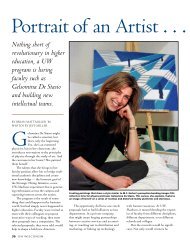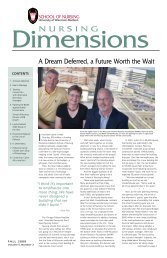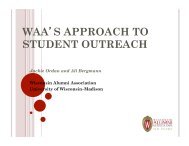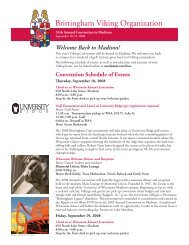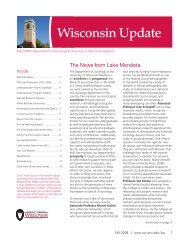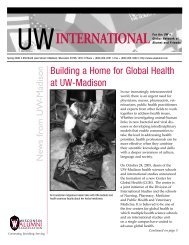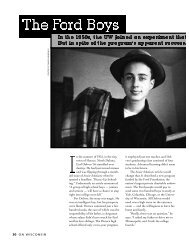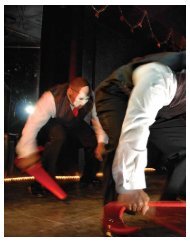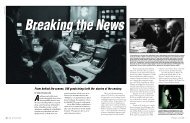The Last Fugitive (pdf file) - Wisconsin Alumni Association
The Last Fugitive (pdf file) - Wisconsin Alumni Association
The Last Fugitive (pdf file) - Wisconsin Alumni Association
You also want an ePaper? Increase the reach of your titles
YUMPU automatically turns print PDFs into web optimized ePapers that Google loves.
By Doug Moe ’79<strong>The</strong> tips started comingalmost immediately.On October 31, 1970, two monthsafter a bomb exploded outsideSterling Hall on the UW-Madisoncampus, a waitress in a restaurantin Cleveland, Ohio, thought one ofher customers was Leo Burt, one offour men wanted in connection withthe bombing. She had seen his faceon an FBI Ten Most Wanted poster.Later that night, the customer fromthe restaurant came out of a Clevelandmovie theater, where he had justwatched Easy Rider. As he started toopen his car door, several uniformedpolice officers approached, guns drawn,and told him to put his hands over hishead. An FBI agent approached himand said, “You’re being charged as afugitive from justice.”After an hour of questioning, authoritiesrealized that the man was a secondyearlaw student named RichardRoutman, and not a notorious fugitive.Today, Routman is an attorney inKansas, and every once in a while, hewonders whatever became of Leo Burt.In 2003, thirty-three years after thatHalloween night in Cleveland, FBI specialagent Kent Miller got a call fromDenver. Someone had tipped police thata homeless man in the area might beBurt. Miller, who had worked the Burtcase for fifteen years out of the bureau’sMadison office, compared a photographof the Denver man to age-enhancedimages of Burt the bureau had made.<strong>The</strong>re were resemblances, although thehomeless man’s hair was longer.“He was real mysterious,” Millerrecalls. “He wouldn’t stay in the samehomeless shelter more than four or fivenights, wouldn’t tell anybody where hewas from.”<strong>The</strong> FBI enlisted an employee ofthe homeless shelter, who managed toretrieve a soda can the man had held.But the prints did not match. <strong>The</strong> homelessman was not Leo Burt.<strong>The</strong> tips keep coming, but they arealways wrong.This summer, thirty-five yearswill have passed since the August nightwhen four young radicals parked a vanfull of explosives in the driveway outsideSterling Hall. Targeted at the ArmyMath Research Center as a protestagainst U.S. involvement in the VietnamWar, the bomb killed Robert Fassnacht,a thirty-three-year-old postdoctoralresearcher in physics, and touched off anFBI manhunt for the bombers.Three men who carried out thebombing — erstwhile UW student KarletonArmstrong, his brother DwightArmstrong, and then-freshman DavidFine — were all eventually arrested,served time in prison, and have gotten onwith their lives. But their suspectedaccomplice, Leo Frederick Burt x’70,remains at large, making him perhaps thelast fugitive of the Vietnam era. Thousandsof tips have been investigated,hundreds of theories advanced, and themystery of Burt has only deepened.After he published Rads, his 1992book about the bombing, newspaperreporter Tom Bates MA’68, PhD’72thought he might hear from Burt. Whenhe didn’t, Bates grew even more fascinatedby the fugitive. In 1995, Bateswrote a long story for a newspaper inOregon, claiming Burt was theUnabomber, the domestic terrorist whokilled three people and injured dozensmore with bombs, usually mailed, from1978 to 1995. Bates based his claimlargely on similarities between theUnabomber’s “Manifesto,” which hadbeen recently published by the New YorkTimes and Washington Post, and an articlewritten by Burt for the left-wing journalLiberation after he disappeared into theunderground in 1972. <strong>The</strong>re were strikingsimilarities in the prose, but the maneventually arrested as the Unabomberwas Ted Kaczynski, not Leo Burt.Through the years, there have beenrumors of sightings — in Norman, Oklahoma,in the early 1970s; in Algeria in1972; and in Costa Rica in 1990. Nonehave panned out. If anything, it is theutter lack of credible information onwhat has become of Burt that most distinguishesthe case.That’s what struck Allan Thompson,the Madison FBI agent who handled the“Leo simply disappeared.investigation prior to Miller, about thecase when I talked to him in 1995. “I didfugitive work for twenty-three years. Inevery case I worked, someone in thewoodwork knew where the person was.Family, friends — somebody,” he toldme. “With Burt, there was an intenseinvestigation of his parents and relatives.Nothing came of it. Not one iota or indicationin twenty-five years that he’s beensighted, heard from, or spoken to.”But if Leo Burt has vanished, theinterest in him has not. Joe Brennan, Jr.,a thirty-six-year-old student in the graduatewriting program at Johns HopkinsUniversity, is currently revising a lengthymanuscript about Burt, with the workingtitle <strong>The</strong> <strong>Last</strong> Radical. Brennan’s interestin Burt comes from his father, who was aclassmate and rowing teammate of Burtat Monsignor Bonner High School inPennsylvania. Brennan thinks Burt’supbringing, and especially his involvementin rowing, is critical to understandingwhat happened in August 1970 andperhaps the years since.Burt was born April 18, 1948, into amiddle-class, Catholic Philadelphia family.He and his six siblings grew up in abrick bungalow, across the street from acemetery. Leo was an altar boy, and Fridaydinners in the Burt home were fishSUMMER 2005 29


